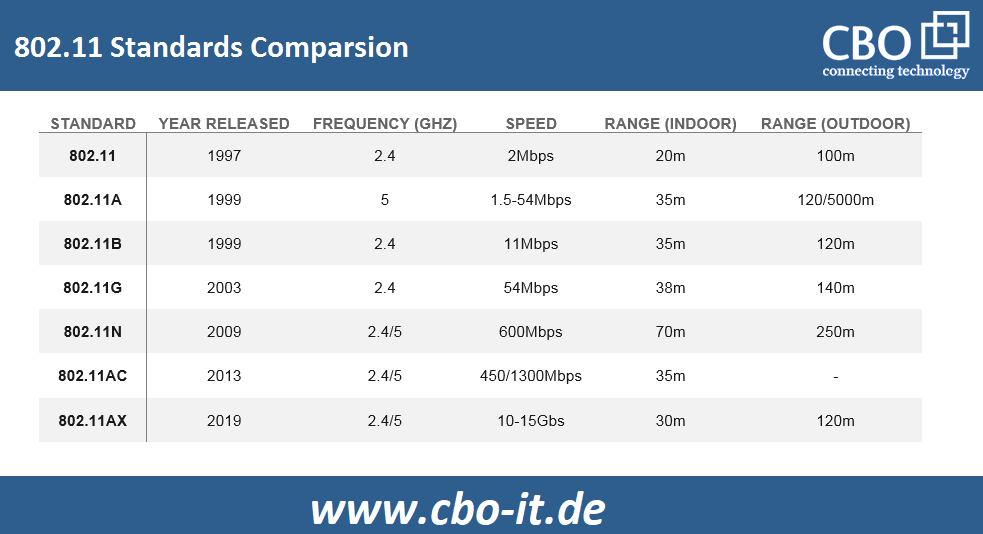Wi-Fi is a general term used by all literate or illiterate to refer to wireless internet access. In the digitized world, however, things are not are simple as in ordinary life. In a machine world, Wi-Fi has a specific trademark belonging to a certain Alliance, a committee that authorizes that all accessories using Wi-Fi must meet IEEE 802.11 standards. Therefore, there are a plethora of 802.11 Wi-Fi standards that your digital devices use to get connected to the Internet.
These standards undergo different changes from time to time to update themselves as per the requirements of the users. For instance, accessibility at various locations and upgrading the speed of your wireless connections.
Before jumping right at the 802.11 standards, let's have a look at the charts below first. Here is the comparison of different 802.11 Wi-Fi standards.
802.11:
It was created in 1997 and is considered the original standard of wireless internet. Although, this version is currently defunct.
This standard gives a maximum speed limit of 1Mbps but its biggest disadvantage is that the current digital devices do not support this version, whereas the ones which do support it are no longer being manufactured.
802.11a :
This version of the wireless connection was created after two years of the prior mentioned version, that is in 1999. Most of the devices back then used the 2.4GHz Wi-Fi band whereas this version works on the 5GHz band. Nonetheless, it was developed with the optimism of general market acceptance owing to its faster speed and maximum data rates ranging from 1.5Mbps to 54Mbps.
802.11b :
It was also created in the same year as 802.11a wireless standards in 1999. It was a less updated version as it used a 2.4GHz Wi-Fi band, which was a typical signaling frequency of ordinary radio but still proved itself quite beneficial regarding the popularity of Wi-Fi. It became the priority of most sellers because of its frequency and low production costs.
It gives a maximum speed of almost 11Mbps. However, this standard was at a great disadvantage because its connectivity was interrupted by any near cordless devices such as microwaves, phone, ovens, etc which works in the same 2.4GHz range.
802.11g:
This version of the wireless connection is also being referred to as Wi-Fi 3 as it is a combination of both 802.11a and 802.11b. It was developed in 2003, which came as a great improvement regarding data rates with 54Mbps almost. It spread like a forest fire in its adaptability due to its maintenance of the reliable 2.4GHz Wi-Fi band. Its biggest achievement is its compatibility with the old devices. For instance, 802.11b APs works efficiently with 802.11g adapters.
802.11n:
This standard is usually referred to as Wi-Fi 4 or N wireless connection and uses various antennas and digital signals, unlike 802.11g. Such connection is called MIMO technology. Although it was developed with an improved version of the bandwidth rates than 802.11g standards it was ratified even more by the digital industry to meet the standards in 2009. This improvement enhanced its bandwidth rates almost to 600Mbps.
It provides a high signal intensity over a wide range of locations than the previous standards. Its only disadvantage is its high cost of purchase, leading to making users settle for the other standards.
802.11ac:
It was developed in 2014 and is also known as Wi-Fi 5. It comes with dual-band technology, that supports both 2.4GHz and 5GHz wireless bands, allowing up to 1300Mbps bandwidth on 5 GHz and almost 450Mbps bandwidth on 2.4GHz. It provides a wide range of compatibility with almost all the wireless standards old or new, for instance; 802.11a, 802.11b, 802.11g, and 802.11 n.
802.11ax:
Also called Wi-Fi 6, which is the fastest of all the wireless standards. It is approximately 10 times faster than 802.11ac. It is compatible with both 2.4Ghz and 5GHz bandwidths and provides a maximum data range of 1.3Gbs.

CONCLUSION:
Other than these mentioned Wi-Fi standards, the digital market is coming up with various other Wi-Fi standards with each passing second. For instance, 802.11ba, 802.11 ay, 802.11az, 802.11ak, and 802.11aj but not all the versions can communicate digitally.
Digital devices using the same Wi-Fi standards can easily communicate and exchange data with one another. However, devices using different Wi-Fi standards may create troubles while connecting.
 English
English
 Deutsch
Deutsch
 Espaniol
Espaniol










